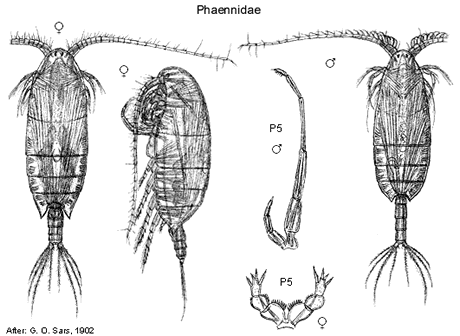 |
||||||
|
|
|
|
|
|
Calanoidea: FamiliesJ.M. Bradford-GrievePhaennidae Sars, 1902
Description. Female. Anterior head in dorsal view pointed, or crested, or rounded or bluntly triangular; lenses or reflectors present, or absent. Rostrum with 2 filaments, or without filaments; rostral margin extends into 2 points, or extends into 1 blunt protrusion, or extends into 2 blunt protrusions, or not extended. Cephalosome and pedigerous somite 1 fused or partly fused, or separate; pedigerous somites 4 and 5 fused or partly fused, or separate. Posterior corners of prosome in lateral view bluntly rounded, or triangular or obtusely pointed; dorsal view symmetrical. Genital double-somite symmetrical in dorsal view; gonopores close together and totally covered by single genital operculum; with pair of seminal receptacles; with pair of copulatory pores that are completely covered by genital operculum. Caudal rami symmetrical; seta VII located ventrally. Mouthparts. Antenna 1 with 21-25 free segments; ancestral segments X and XI fused. Antenna 2 exopod with 6-7 free segments; 7-8 setae; basis and endopod separate. Mandible basis with 3 setae; endopod terminal segment with 8-9 setae. Maxilla 1 basal exite seta absent; exopod extends short of endopod distal border. Maxilla 2 coxal epipodite seta absent; endopod setae of sensory type; endopod with 1 worm-like seta; endopod with 7 brush-like setae. Maxilliped coxal endite 2 with 2 setae. Legs. Leg 1 basis inner distal seta inserted directly on surface of joint, or absent; outer seta present, or absent; endopod with 1 segment; exopod with 3 segments; exopod segment 1 with outer distal spine; exopod segment 3 with 3 inner setae. Leg 2 endopod with 2 segments; exopod with 3 segments; exopod segment 3 with 3 outer spines. Leg 3 basis outer distal spine absent; endopod segment 3 with 5 setae. Legs 3 and 4 endopod with 3 segments; exopod with 3 segments; exopod segment 3 with 3 outer spines; exopod segment 3 with 4 inner setae. Leg 4 endopod segment 3 with 5 setae. Legs 2-4 surfaces strongly spinulose, or weakly spinulose; terminal spine with outer border serrated. Leg 5 present, or absent; very dissimilar from legs 2-4; coxa inner border without seta; when present, coxae and intercoxal sclerite separate, basis separate from or fused to 1-segmented exopod which is bordered by terminal and usually lateral articulated spines, surfaces of segments spinous or naked (Phaennocalanus). Mode of life. Pelagic or benthopelagic, in oceanic waters. Depth distribution. Epipelagic (0-500 m), or mesopelagic (500-1000 m), or bathypelagic (greater than 1000 m). Distribution on sea floor. Less than 100 m, or 100-200 m, or 200-1000 m. Generic composition. This family contains at least eight genera: Brachycalanus Farran, 1905; Cephalophanes Sars, 1907; Cornucalanus Wolfenden, 1905; Onchocalanus Sars, 1905; Phaenna Claus, 1863; Phaennocalanus Markhaseva, in press; Talacalanus Wolfenden 1911; Xanthocalanus Giesbrecht, 1892. There is still a further need to review a number of genera and their families in the Clausocalanoidea.
(Variant) Male (sexually dimorphic characters). Description. Male. Anterior head in dorsal view crested, or rounded or bluntly triangular; lenses or reflectors absent. Pedigerous somites 4 and 5 fused or partly fused. Posterior corners of prosome in lateral view bluntly rounded, or with 1 acute point, or triangular or obtusely pointed. Mouthparts. Mouthparts reduced (especially maxillae 1 and 2). Antenna 1 similar, neither geniculate. Maxilliped coxal endite 2 without setae, or with 1 seta, or with 2 setae; endopod segments 5 and 6 with outer setae normal. Legs. Right leg 5 uniramous; exopod elongate or short, 1-3 segmented, subequal to or much shorter than left exopod. Left leg 5 uniramous; exopod elongate, 3-segmented, subequal to or longer than right exopod.
Cite this publication as: 'Bradford-Grieve, J.M. (2002 onwards). Calanoida: families. Version 1: 2 October 2002. https://crustacea.net'. |
|
|
|
|
|
|
|
|
|
Copyright © Australian Museum, 2002 - 2003
Australian Museum website
